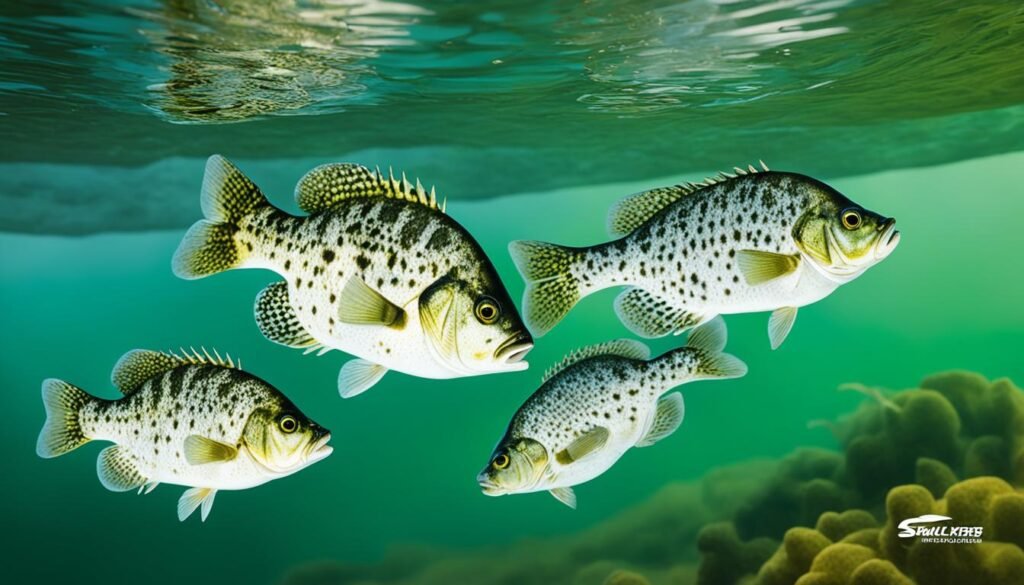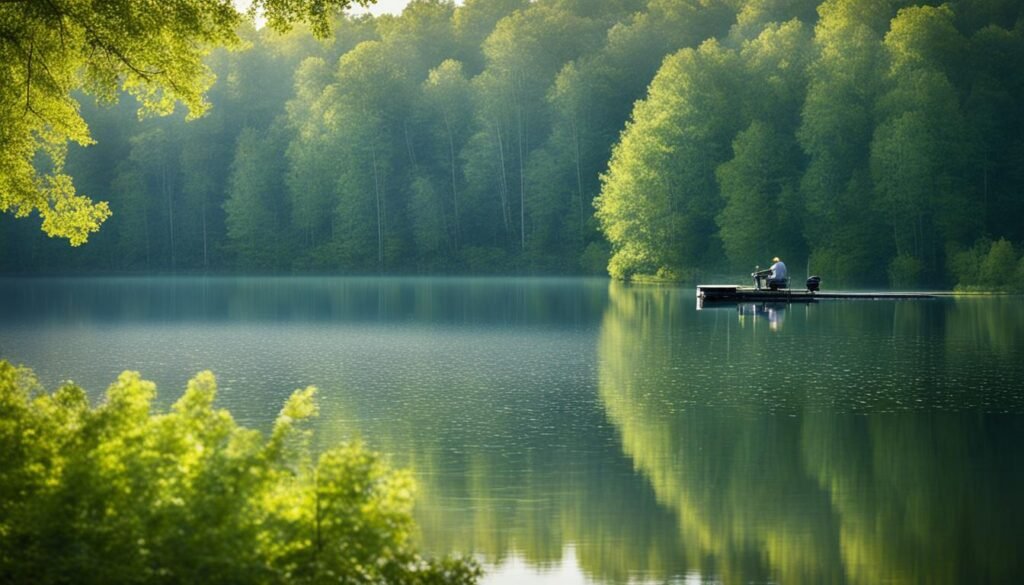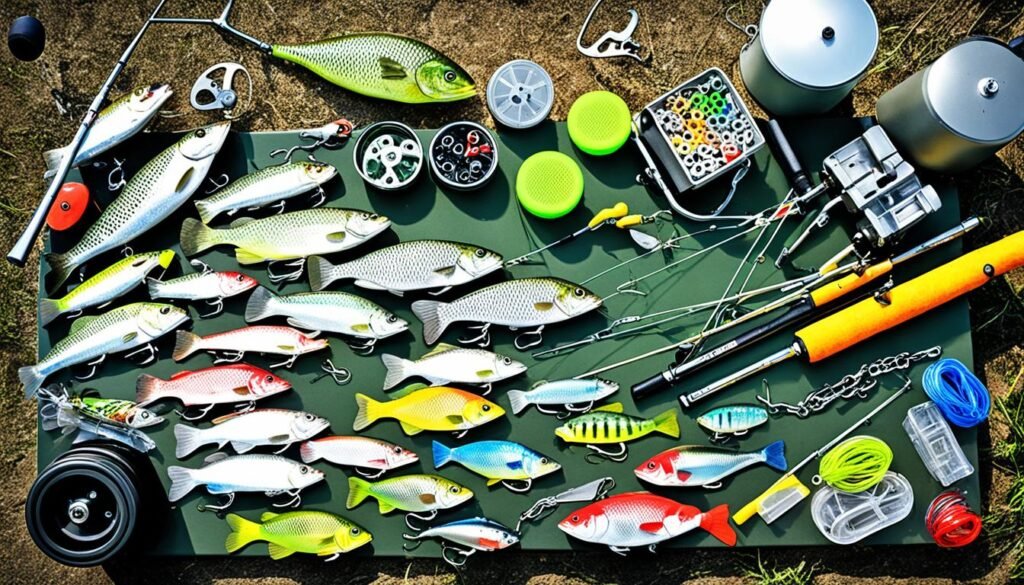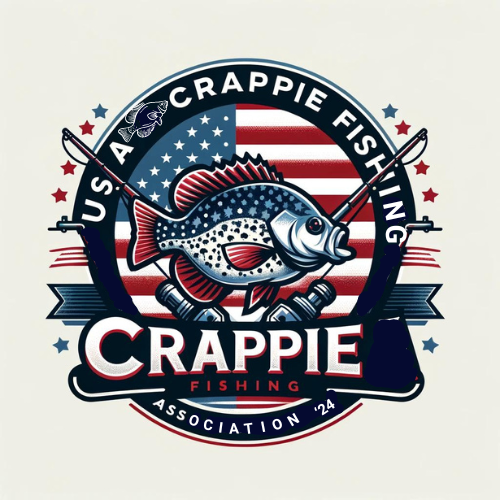Crappie are the true test of angling skill. Catching these elusive fish requires knowledge, technique, and a keen understanding of their behavior. Whether you’re a seasoned angler or just starting out, crappie fishing offers an exciting challenge that will put your angling skills to the test.
Imagine yourself on a peaceful lake, the early morning mist rolling across the water’s surface. You’re armed with your trusty fishing gear, ready to conquer the day. As you cast your line, you can’t help but feel the anticipation building. Crappie are known for their elusive nature, making them a prized catch among anglers.
As you sit patiently, you reflect on the many fishing techniques you’ve learned over the years. From jig fishing to bobber and minnow rigs, you’ve honed your skills, ready to put them to the test. You know that crappie can be found in lakes, rivers, and reservoirs across North America, making them an accessible and exciting target for freshwater fishing enthusiasts.
The sun begins to rise, casting a golden hue over the water. You feel a slight tug on your line, and your heart starts to race. Could it be? Is this the moment you’ve been waiting for? With practiced precision, you reel in your catch, and there it is—a beautiful crappie, a testament to your angling prowess.
Crappie fishing is not just about the thrill of the catch; it’s also about the delicious reward. These fish are not only challenging to catch but also incredibly tasty. Whether you enjoy them pan-fried, grilled, or baked, crappie is a culinary delight that awaits those who can master the art of crappie fishing.
Key Takeaways:
- Crappie fishing is an ultimate angling skill challenge.
- Understanding crappie behavior and habitat preferences is key to success.
- There are various fishing techniques and gear options for crappie fishing.
- Crappie have different habits throughout the year, so timing is important.
- Shoreline fishing can be just as productive as fishing from a boat.
Understanding Crappie
When it comes to crappie fishing, it’s essential to understand the different species and their characteristics. There are two main species of crappie that are popular among anglers: the Black Crappie and the White Crappie. Both species belong to the sunfish family and offer unique challenges and rewards for anglers.
The Black Crappie, also known as Pomoxis nigromaculatus, is characterized by its darker coloration and distinctive speckled pattern. They possess a more intricate arrangement of spots on their bodies, making them easily identifiable. On the other hand, the White Crappie, scientifically known as Pomoxis annularis, features vertical bars along its body, giving it a striped appearance.
Understanding these differences between the Black Crappie and the White Crappie can be crucial for anglers seeking to target and catch more crappie in their fishing endeavors. By recognizing the physical characteristics unique to each species, anglers can tailor their fishing techniques and strategies accordingly, increasing their chances of success.
| Species | Description |
|---|---|
| Black Crappie | Darker coloration with a speckled pattern |
| White Crappie | Vertical bars along the body |
Habitat Preferences of Crappie and Where to Find Them
Crappie, a popular freshwater fish among anglers, have specific habitat preferences that can greatly impact their location. Understanding these preferences is crucial for successful crappie fishing. Crappie are structure-oriented fish that seek areas with minimal current, clear water, and ample cover.
One of the key elements of crappie habitat is the presence of submerged timber or vegetation. Crappie are often found near fallen trees, weed beds, or other types of structures. These structures provide not only protection but also serve as hunting grounds for their prey, making them prime locations for crappie fishing.
Artificial structures, such as docks and pylons, also attract crappie. These man-made structures mimic the natural cover that crappie seek and can be highly productive fishing spots.
To further illustrate the preferred habitat of crappie and where to find them, refer to the following table:
| Habitat Element | Description |
|---|---|
| Submerged Timber | Crappie are often found near fallen trees and submerged wood structures |
| Vegetation | Crappie seek areas with abundant underwater vegetation, such as weed beds |
| Docks and Pylons | Artificial structures like docks and pylons act as attractive hunting grounds for crappie |
By targeting these types of areas rich in submerged timber, vegetation, and artificial structures, anglers can significantly improve their chances of locating and catching crappie. Being aware of the crappie’s habitat preferences is key to a successful fishing expedition.
“Understanding their habitat preferences and where to find them can greatly increase angler’s chances of success.” – Anonymous
Grouping Behavior of Crappie
Crappie, being schooling fish, exhibit fascinating behavior when it comes to grouping together. Understanding their grouping behavior is vital for anglers looking to locate and target schools of crappie effectively.
These fish have a natural affinity for congregating near food sources or breeding grounds. They tend to stay deep underwater during the day, often near structures or drop-offs, where they feel safe and secure. However, during the periods of dawn and dusk, crappie become more active and move to shallower waters to feed.
By recognizing these habits, anglers can strategically plan their fishing trips to coincide with the crappie’s feeding patterns, increasing their chances of success. Whether you’re fishing from a boat or the shoreline, keeping an eye out for these schooling fish is key.
“Understanding the grouping behavior of crappie is like deciphering their secret code. It opens up a world of possibilities for anglers, enabling them to find the jackpot – a school of crappie that’s ready to bite!”
To give you a clearer picture of crappie’s grouping behavior, here’s a table summarizing their schooling patterns:
| Behavior | Description |
|---|---|
| Moving in schools | Crappie typically swim in tight-knit schools, often consisting of individuals of similar size. |
| Near structures | Crappie are attracted to structures like fallen trees, weed beds, and docks. They seek shelter and use these structures as ambush points for feeding. |
| Deep during the day | Crappie prefer deep water during the day, where they feel protected from potential predators and excessive sunlight. |
| Shallow during dawn and dusk | Dawn and dusk are prime feeding times for crappie. They move to shallower waters in search of prey during these periods. |

Diet of Crappie
When it comes to the diet of crappie, they are opportunistic feeders that have an appetite for a variety of prey. Their food preferences play a crucial role in determining the most effective bait and lure options for anglers.
Primary among their dietary choices are small fish, with minnows being a particular favorite. These little swimmers make up a significant portion of a crappie’s diet and are highly enticing to them. Anglers who use minnows as bait often find success in attracting crappie.
In addition to small fish, crappie also consume a range of other creatures that they encounter in their aquatic environment. These include insects, crustaceans, and even small amphibians. The abundance of these food sources allows anglers to experiment with different bait options to entice crappie.
“Understanding the dietary preferences of crappie can be a game-changer for anglers. By using bait and lures that mimic their favored prey, anglers can greatly increase their chances of success.”
When choosing bait for crappie fishing, it’s essential to consider their natural diet and select options that closely resemble their preferred prey. This strategy can help anglers attract more crappie and improve their overall fishing experience.
| Prey Type | Significance in Crappie Diet |
|---|---|
| Small Fish | Main source of food for crappie, particularly minnows |
| Insects | Secondary food source for crappie |
| Crustaceans | Occasional part of crappie’s diet |
| Small Amphibians | Less common prey for crappie |
Understanding the crappie’s diet can help anglers make informed decisions about the best bait and lures to use. By mimicking the small fish, insects, crustaceans, and even small amphibians that crappie naturally feed on, anglers can increase their chances of a successful and rewarding fishing trip.
Crappie Fishing Basics
Crappie fishing is an exciting and rewarding activity that requires knowledge of various techniques. Understanding the basics of each technique can help anglers choose the right approach for catching crappie. Let’s explore three popular techniques: the bobber and minnow rig, spider rigging, and jig fishing.
Bobber and Minnow Rig
The bobber and minnow rig is a classic method for crappie fishing. It involves suspending a live minnow or artificial bait beneath a bobber at a specific depth. This technique is effective for targeting crappie near structures such as docks, submerged timber, or brush piles. The bobber serves as an indicator when a crappie bites, giving anglers a chance to react swiftly and set the hook.
Spider Rigging
Spider rigging, also known as tightlining or long-lining, is a technique that involves fishing with multiple rods spread out from the boat. Anglers attach jigs or minnows to each rod and position them at different depths to cover a larger area. Spider rigging is particularly useful when searching for schools of crappie in open water or along drop-offs. It allows anglers to present their bait at various depths simultaneously, increasing the chances of attracting crappie.
Jig Fishing
Jig fishing is a versatile technique that involves using a weighted jig with a soft plastic body or feathers. Anglers can cast or vertically jig the lure to imitate the movements of small baitfish. Jig fishing is effective year-round and can be used in various water conditions, making it a popular choice among crappie anglers. Anglers can experiment with different jig colors, sizes, and retrieval speeds to find what works best.
By mastering these techniques, anglers can increase their chances of a successful crappie fishing trip. Each technique offers its own advantages and requires specific gear and skills. Understanding the behavior and habits of crappie will further enhance an angler’s ability to successfully catch these elusive fish.

Recommended Gear Basics
When it comes to crappie fishing, having the right gear can make all the difference. Here are some essential pieces of gear that every crappie angler should consider:
Ultralight Spinning Reels
To maximize your chances of detecting a crappie’s subtle bite, it’s recommended to use ultralight spinning reels. These reels offer the perfect balance of sensitivity and flexibility, allowing you to feel even the slightest nibble. With an ultralight spinning reel, you can cast lightweight lures with ease and precision, increasing your chances of landing more crappie.
Sensitive Rods
A sensitive rod is a key component of any crappie angler’s gear arsenal. Opt for a rod that is both light in weight and highly sensitive. This will enable you to detect the faintest nibbles and bites, ensuring that you never miss an opportunity to hook a crappie. Look for a rod that measures around 5 to 5 1/2 feet in length, as this will provide the ideal blend of maneuverability and sensitivity.
Light Lines
Using light lines is essential in crappie fishing. A 4-6 pound test line is typically sufficient for targeting these crafty fish. Light lines allow for better casting distance and accuracy, and they are less likely to spook crappie in clear water conditions. Additionally, they provide better sensitivity, allowing you to feel even the slightest movement when a crappie takes the bait.
By equipping yourself with ultralight spinning reels, sensitive rods, and light lines, you’ll be well-prepared to tackle the challenge of crappie fishing. These gear basics will help you improve your chances of detecting bites, casting accurately, and ultimately, reeling in more crappie.

Crappie Fishing Techniques
When it comes to crappie fishing, utilizing the right techniques can make all the difference in your success on the water. Whether you’re a novice angler or an experienced pro, learning and experimenting with different techniques can help you maximize your catch. Below are some popular crappie fishing techniques that you can try:
1. Bobber and Minnow Rig
The bobber and minnow rig is a classic crappie fishing technique that is simple yet effective. It involves using a small bobber to suspend a live minnow at a specific depth in the water column. This technique allows the minnow to swim naturally, attracting crappie and enticing them to bite.
2. Spider Rigging
Spider rigging is a technique commonly used by anglers who want to cover a larger area of water and target multiple crappie simultaneously. It involves setting up multiple fishing rods, each rigged with a baited hook, and spreading them out in a radial pattern around the boat. This technique allows you to present your baits at various depths and angles, increasing your chances of attracting crappie.
3. Jig Fishing
Jig fishing is a versatile technique that can be used in various fishing scenarios. It involves using a jig lure, which is a weighted hook with a small, often brightly colored, soft plastic bait attached to it. Jigs can be fished at different depths and retrieved with various techniques to mimic the natural movements of prey, effectively attracting crappie.
4. Shooting Jigs
Shooting jigs is a technique that requires skill and precision. It involves using a specialized rod and reel setup to “shoot” a jig lure under docks, overhangs, or other structure where crappie may be hiding. This technique allows you to present the bait in hard-to-reach areas and can be highly effective in enticing crappie to bite.
5. Fishing with Crankbaits
Fishing with crankbaits is another technique that can be effective for targeting crappie, especially when they are actively feeding. Crankbaits are hard-bodied lures with a diving lip that causes them to dive to a specific depth when retrieved. By selecting the right crankbait and fishing at the appropriate depth, you can imitate the movements of crappie’s preferred prey and trigger strikes.
Remember, while these techniques have proven successful for many crappie anglers, it’s essential to adapt your approach based on water conditions, weather, and the behavior of the fish. Don’t be afraid to experiment and try new techniques to find what works best for you.
Seasonal Habits
Crappie, like many other fish species, exhibit distinct seasonal habits that can greatly influence their behavior and location. Understanding these patterns is crucial for anglers looking to maximize their success on the water. Let’s take a closer look at the crappie’s seasonal habits and how they can impact your fishing strategy.
Spawning in the Spring
One of the most significant events in the crappie’s annual cycle is the spring spawn. During this time, crappie gather in shallow waters near submerged vegetation or other suitable spawning areas. The spawn typically occurs when water temperatures reach around 55 to 65 degrees Fahrenheit. Male crappie will build nests on the substrate, while females lay their eggs and then move on. This period presents an excellent opportunity for anglers to target spawning crappie and catch them in abundance.
Winter Fishing
As the temperatures drop and winter sets in, crappie adapt to the colder conditions by moving deeper and seeking shelter in woody cover or submerged structures. They prefer staying in deeper waters where the temperature is more stable. Anglers will need to adjust their fishing techniques and target these deeper structures to locate schools of crappie during the winter months. Vertical jigging near the bottom or using live bait can be effective ways to entice winter crappie into biting.
Fall Fishing
In the fall, as the weather begins to cool down, crappie start to transition from deeper waters to the shallows again. They often gravitate towards shoreline cypress trees, which provide both cover and a food source as leaves and insects fall into the water. Fall fishing for crappie can be highly productive, as they actively feed in preparation for the upcoming winter months. Casting around shoreline structures or using small jigs near submerged vegetation can yield great results during this time.
To summarize, crappie exhibit distinct seasonal habits that include spawning in the spring, congregating in deep structures during the winter, and hovering near shoreline cypress trees in the fall. Understanding these habits allows anglers to adapt their fishing strategies accordingly and increase their chances of landing a successful catch.
Stay tuned for the next section as we delve into the fundamentals of shoreline fishing for crappie!
Shoreline Fishing
Shoreline fishing is a fantastic option for anglers looking to catch crappie without the need for a boat. Many of the best fishing spots for crappie can be accessed from the shore, offering excellent opportunities to land these prized fish. Let’s explore some popular shoreline fishing locations and techniques.
Bridges
Fishing from bridges can be highly productive as they provide excellent cover for crappie. The shaded areas beneath the bridge offer protection and attract both baitfish and crappie. Casting near the bridge pillars or along the edges can yield great results. Consider using jigs or small minnows as bait to entice crappie in these areas.
Docks
Crappie often seek shelter and food around docks. The pilings and shaded areas under docks create an ideal habitat for these fish. Casting close to the docks and allowing your bait to sink near the protruding structure can increase your chances of attracting crappie. Experiment with different bait options such as live minnows or small jigs to entice these fish.
Weed Beds
Weed beds are another prime location to target crappie from the shoreline. These areas offer both cover and an abundance of food, making them attractive to crappie. Cast your bait near the edges of the weed beds or into any gaps within the vegetation. Slowly retrieve your bait to mimic the movement of small prey, enticing crappie to strike.
Blowdowns
Blowdowns, fallen trees along the shoreline, create a natural habitat for crappie. These structures provide cover and attract both baitfish and larger predators. Crappie often congregate around blowdowns, making them excellent fishing spots. Carefully cast your bait near the submerged branches and allow it to explore the surrounding area. This technique can yield some exciting crappie catches.
Shoreline fishing provides anglers without a watercraft the opportunity to enjoy the thrill of crappie fishing. By targeting bridges, docks, weed beds, and blowdowns, anglers can access prime fishing locations and increase their chances of landing crappie. Remember to be patient, experiment with different techniques, and adjust your strategies based on the conditions of the shoreline.
Experience Florida Crappie Fishing
Florida, also known as the sunshine state, offers anglers an exceptional opportunity for crappie fishing. With its vast network of water systems and lakes, Florida is home to a thriving population of crappie, attracting fishing enthusiasts from all over. Whether you are a seasoned angler or a beginner, Florida lakes provide the perfect setting for an unforgettable fishing experience.
In Florida, late fall to early spring is considered the prime time for crappie fishing. During this period, the water temperatures are ideal, and crappie is more active, increasing your chances of landing slab-size fish. As you immerse yourself in the peaceful surroundings and cast your line, the anticipation builds, knowing that each moment could result in a thrilling catch.
Florida’s natural beauty and abundant wildlife enhance the thrill of crappie fishing. The picturesque landscapes, teeming with diverse flora and fauna, create a serene setting as you pursue the elusive crappie. The experience of casting your line surrounded by Florida’s breathtaking scenery is as rewarding as the catch itself.
So, pack your gear, choose your favorite fishing spot, and embark on a crappie fishing adventure in the sunshine state. Florida’s rich fishing heritage and vibrant ecosystem await, promising an angling experience like no other. Prepare to reel in slab-size crappie and create memories that will last a lifetime.
Conclusion
Crappie fishing is an ultimate angling skill challenge that offers excitement and a delicious reward. Understanding the different techniques, gear, and habits of crappie can greatly improve an angler’s chances of success. Whether fishing from a boat or the shoreline, there are ample opportunities to catch these elusive and crafty fish. Enjoy the ultimate fishing challenge and embrace the passion for crappie fishing.
To enhance your crappie fishing experience, here are a few tips:
1. Know the habitat: Familiarize yourself with the preferred habitat of crappie, such as submerged timber, vegetation, and structure-oriented areas. This knowledge will help you locate and target these cunning fish.
2. Master the techniques: Explore various crappie fishing techniques, including the bobber and minnow rig, spider rigging, jig fishing, shooting jigs, and fishing with crankbaits. Each technique offers unique advantages, and finding the right one for the conditions can make all the difference.
3. Invest in the right gear: Use ultralight spinning reels, sensitive rods, and light lines to maximize your chances of detecting a crappie’s subtle bite and landing your catch with finesse.
By following these crappie fishing tips and harnessing your angling skills, you can embark on a thrilling fishing adventure and create memorable experiences on the water.
